Vol. 2, Issue 54 - November / December 2014
Posted: Friday 14th November 2014
Having managed to reduce our collection to a manageable number I made a resolution not to buy any more frames for restoration. However, a month or so ago a good friend of mine sadly passed away and another friend was disposing of his cycles on behalf of the widow. Ken had been a cyclist from the immediate post-war years until shortly before his death – he never had a car nor learned to drive. There are some images of Ken on both solo and tandem on pages one and two of the Photo Gallery on the website.
Like most of us at the time, Ken was called up for National Service, which he did in the army. He was posted to Korea, known as the forgotten war in the UK, where he spent a long time serving in horrific conditions – not helped by the attitude of the armed forces regarding equipment for personnel in this era.
Finally, he was given the good news that he was to return home and boarded the cramped troopship Windrush for the trip back to the UK. Sailing through the Mediterranean the engines in the Windrush blew up and she sank straight away. All personnel ended up in the water and after about eight hours swimming, during which time the officers were rescued, eventually it was the turn of the troops to be pulled out of the water and onto another boat that had answered the Mayday calls.
While service personnel were serving overseas they only received a small part of their due wages – the rest held until they returned home to the UK to be paid in a lump sum. In 1957 when he was demobbed, Ken being a very keen cyclist decided to spend part of this money on two frames which he had built by Ron Cooper at Gillott, a 23″ Fleur de Lis (as Gillott insisted on calling them) for himself and a 22½” frame with Nervex Professional lugs for his wife. Both had track ends but as was common at the time they had clearance for mudguards and mudguard eyes.
A typical time trial/club use set-up which would sometimes be ridden to the event with guards that were taken off at the start and left lying on the verge to be refitted at the finish. This is the reason that some mudguard eyes have a rectangular slot with a rectangular head on the matching bolt. The bolt was slipped in with the slots lined up and turned through a right angle before tightening the tiny wingnut, which was very prone to digging into the fingers. The more affluent competitors would change from HP wheels to sprints which they carried on sprint wheel carriers (see images below) bolted to the front wheel.
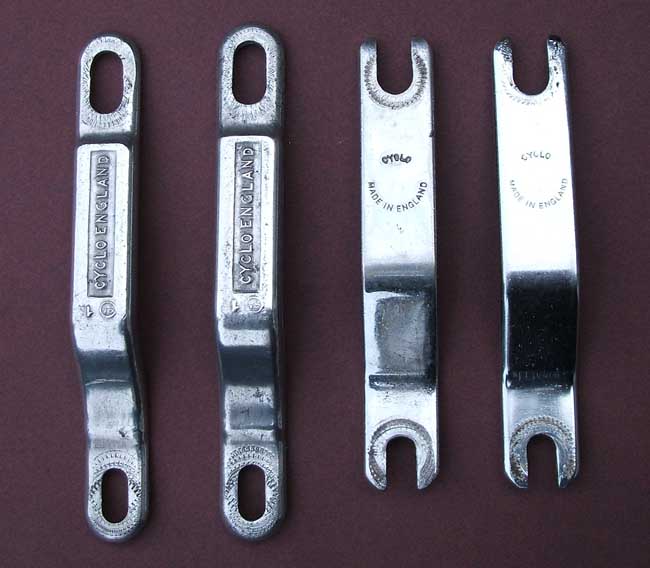
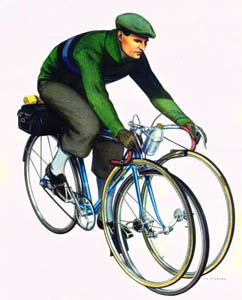
I had always coveted Ken’s Fleur de Lis and often told Ken how much I liked it but I never pressured him into selling as I knew he loved to go to his garden shed and see this memoir of a happy time of his life. He was not alone in this as so many collectors I know are actually trying the recreate their ‘misspent youth’ in the same way. Only a few are lucky enough still to own the machines they rode in their prime.
Now to the point of all this. When I learned that someone was selling the Gillotts on behalf of Ken’s widow I broke my ‘no more bikes’ rule and am now the proud owner of my only Gillott (Patricia has a small Gillott Spearpoint). The frame was in good condition and the chromed rear ends – 6″ seemed to be the rule of the day when chromed ends were offered -usually as an extra, but sadly the chrome on the forks has suffered the ravages of time and are on their way to Prestige plating (see item below).
Over a dozen or so years I have ridden many miles with Ken and on one ride we were discussing Chater-Lea hubs and Ken explained that they were known for failure of the spoke holes, especially in the large-flange version and that he had this happen to a pair on his wheels way back. He went on to tell me that he had cut off the flanges and rebuilt them as small flange. When his shed was cleared out the following were found carefully preserved:
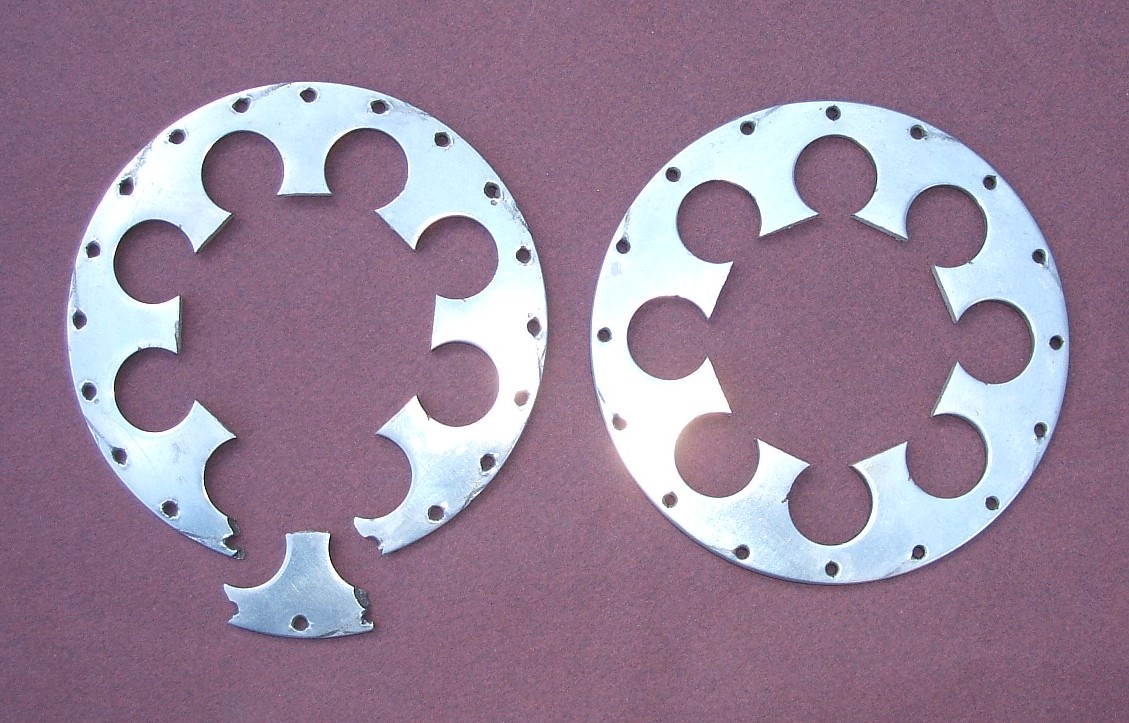
As you can see they were the flanges left over after the conversion. The area where the spokes had originally pulled out shows clearly and it can be seen that the holes are rather close to the outer edge. Chater may have got away with this except that the flanges are also quite thin – no doubt designed for lightness. I have shown one front and one rear but I do have the complete set of four as well as the wheels built with the modified hubs. They are built with a pair of 27″ HP alloy rims which I have never seen before, not helped by the fact that they are unmarked. As I don’t know exactly when the hubs failed it is hard to date the rims. I have a feeling we may be talking late 1940s.
An interesting feature of the Chater hubs was the fact that the axles were hollow with a grease nipple in the end to allow greasing without dismantling cones etc. The axle is hollow with holes to allow the grease into the bearings – very cunning but it must reduce the axle strength
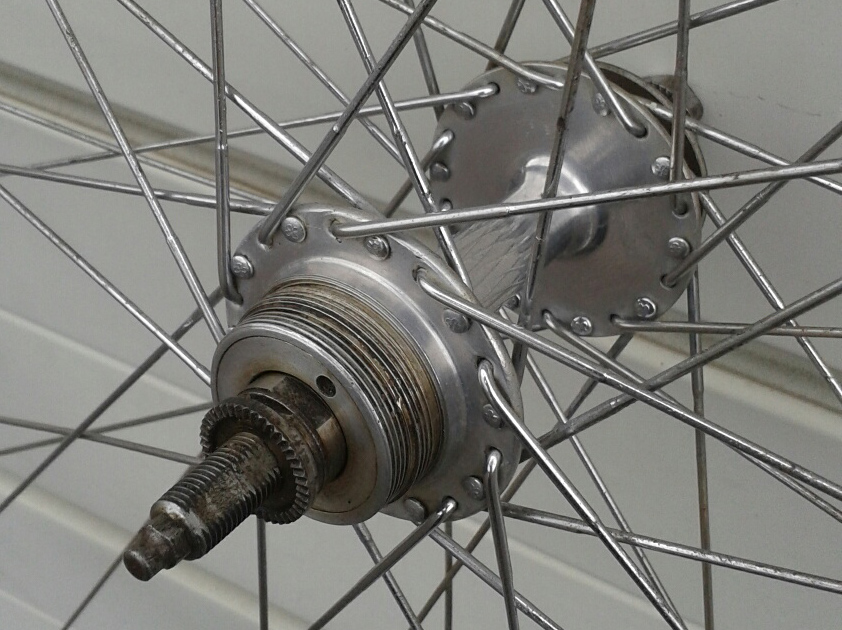
I think Chater-Lea hubs just about come into the ‘hen’s teeth’ category so I hope to use the wheels after careful cleaning and polishing. Chater-Lea produced both large-flange and small-flange hubs and the small-flange listed look very much like the ones modified by Ken.
Ken was one of those people who could find a practical solution to any problem. Back in the days when prescription goggles entailed having a second set of lens clipped to the inside and were very expensive, Ken appeared with a pair of goggles he had made by cutting down a pair of older lens and fitting them into a pair of cycling goggles.
I also obtained from Ken’s estate a beautiful Holdsworth Cyclone de Luxe lugged stem designed to complement the ornate frame lugs of the Holdsworth frame. This stem was available fully chromed or with chromed lugs and red centre tube. Sadly the chrome on mine was far from perfect so it went to Prestige with the forks and I may use it on the Gillott Fleur de Lis when I am ready to build.

It seems we have a habit of acquiring rare custom built stems and using them with inappropriate frames – Patricia has an R O Harrison lapped stem on her Hetchins.
As I said above, after a long break I have sent some parts (from the Gillott) to Prestige Plating for re-chroming. A pair of forks actually and I was quite worried to arrive home after a ride to find a message on the answerphone asking me to get in touch with them. When I rang they asked if I knew that the paintwork would not survive the operation. I was quite puzzled and explained that I understood this and assumed just about everyone would and that when returned to me the forks – complete with frame would then go for re-spray. The very pleasant and efficient lady at P P told me that a client had sent a frame with paintwork in good condition to them and asked to have the re-plating done without damaging the paint. He became quite irate when it was explained that it didn’t work like this and accused them of incompetence and not knowing their job. They also explained that there had been a problem with frames and forks built with the small vent holes to allow gases and heat to escape during brazing. It seems that fluids would dribble out ruining the finish and causing them endless problems.
On 28 September Patricia and I joined a group of friends for a ride organised by Bob Johnson around the Surrey hills, including the well-known Box Hill which was used for the Olympic road race in 2012. Several riders were using the event as a shakedown ride for bodies and bikes in anticipation of L’Eroica which was taking place on the next Sunday. We were blessed with a great day weather-wise and it was good to tackle some of the hills in this area. Particularly memorable was the ride through Denbies vineyard which wound its way uphill through the vines and through trees nearer to the top at Ranmore Common. The road was traffic free so we were able to enjoy the climb without worrying about overtaking cars.
The bikes spanned the era 1953 to 1988 and were good examples of classic machines over this period. Several had had the magic ‘Bob Johnson build’ and I still have to find out how he manages to find so many fantastic components for each build he does.
We had a great weekend and participation was made possible by good friends Terry and Geoff who helped us overcome the restrictions on rail travel for the weekend. Not only tha,t we all had a good meal together on the Saturday evening before driving out to the start down memory lane as we used many of the roads we rode when living in London some 17 – 22 years ago. It was amazing to see the numbers of cyclists on the roads, especially in Richmond Park. When we rode there years ago one encountered a few riders here and there but now the roads through the park are thronged with cyclists of all ages riding everything from commuter bikes to top=-of-the- range carbon road bikes.
Sunday September 28 2014 Riders
| Terry Garrett | 1953 Ernie Clements Mixte |
| Richard Jarvis | 1956 Bianchi ‘Campione Del Mondo’ |
| Jane Jarvis | 1959 Ephgrave ‘No.1’ |
| Patricia Killiard | 1963 Carpenter ‘Olympic Mass Start’ |
| Dave Jarvis | 1963 Hetchins ‘Experto Crede’ |
| Lisa West | 1964 Lomas |
| Peter Underwood | 1964 Pennine ‘Italia’ |
| Adam Young | 1966 Peugeot |
| Nick Yates | 1967 Claude Butler |
| Alfredo MarcAntonio | 1972 Cinelli ‘Super Corsa’ |
| Helen Blackburn | 1976 Koga Miyata |
| Chris Netherclift | 1976 Chesini ‘Precision’ |
| Geoff Nagle | 1979 Trevor Jarvis ‘Flying Gate’ |
| Tim Dawson | 1980 Alex Singer ‘Sportif’ |
| Rob Blackburn | 1981 Gios ‘Super Record’ |
| David Lindsay | 1982 Ciocc ‘SL’ |
| Richard Busellato | 1982 Pinarello SL |
| Darren Mills | 1983 Guerciotti ‘Record’ |
| Sonny Adorjans | 1984 Faggin ‘Special’ |
| Neil Nash-Williams | 1984 Colnago ‘Super’ |
| John Perry | 1985 Ron Cooper ‘Italia’ |
| Bob Johnson | 1985 Masi ‘Gran Criterium’ |
| Stuart Farrow | 1987 Hetchins ‘Magnum Bonum’ |
| Tim Platten | 1988 Eddy Merckx |
Your description of upgrading a Vintage Frame with modern parts hits on my first bike after a long ”non-cycling” slumber. I found someone selling a Cinelli SC (1983 model) frame set and had to build a bike from it. In the pre-Internet era (and we had none of your nice Jumbles) I had to resort to the Bulletin Board at my local Shop. Someone was selling a Shimano Dura Ace 8 speed group as 9 speed had just come out(and you know those bike guys need to have all the latest).
That bike was my primary rider for a long time and I rode it in many Century Rides. I replaced it with a ”Modern” Ron Cooper with 753 which I built with a combination of Dura Ace/Ultegra. This in turn has become my primary Rider. I am a great fan of being able to shift up and down while climbing.
Your mention of Jim Collier reminds me of Peter Weigle’s story of apprenticing at Witcombs when Jim worked there. The youngsters had no appreciation of Jim and his place in the Cycle Cosmos. Some might have given him a hard time (think 13 year old Students). One day after work Jim asked if they would like to meet Ron Cooper so off they went and Jim introduced them to Ron . He immediately told them that he had learned everything from Jim and that he was someone special. From then on the Young Apprentices treated Jim like he walked on water.
I am heading to High Point, North Carolina next week for the BAMF (Bicycles as a Modern Art Form, I think) and if I see something you might be interested in I will report back. These Events don’t really impress me much as I am an Old Bike Guy and these new builders (non Caps on purpose) spend to much time trying to be Rene Herse.
I made the stand as I was reluctant to use a repair stand that clamps around the top tube especially having just spent a lot of time and money restoring and painting a classic. It is fully adjustable for different wheelbases and is perfect for putting all the parts onto a frame, bottom bracket, brakes, saddle, stem etc. It is also perfect for putting on decals, transfers etc. It can sit on a bench, kitchen table etc. brackets are included for storage on the wall. £75 plus £8.00 postage.
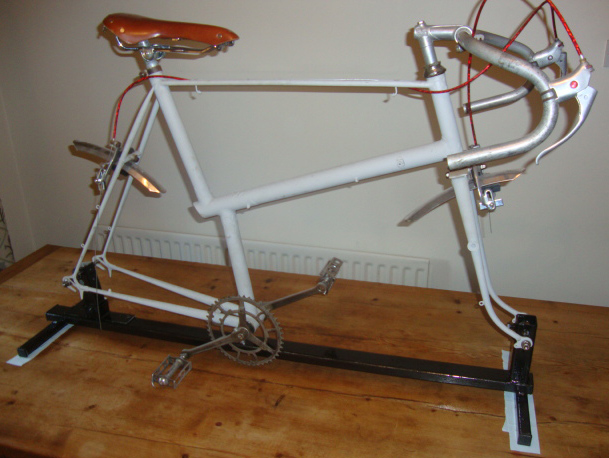
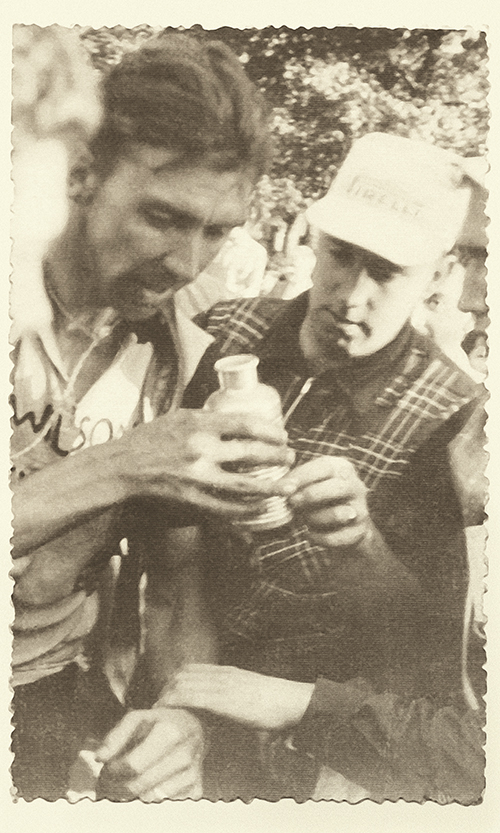
From Wilson’s Cycles at Sheffield:
Regarding the attached photo “JIM WILSON, THE FIRST PROPER TOUR OF BRITAIN..We are trying to find if there’s anyone out there who knows the name of the man handing a bottle to Jim and or possibly the other fellahs helping there?
My Pennine 70085 – John Lewis
When I was a kid living in Yorkshire we had a neighbour called Brian Buckley. In his youth I understand that Brian was a half decent cyclist and as he got older he was able to afford the bike he always wanted. That bike was a Pennine Re Della Corsa built in Bradford by Pennine Cycles, (originally Whittaker and Mapplebeck). The frame number was 70085 making it the 85th bike built in 1970.
Brian used this for a couple of years but as his business took off he had less and less time to ride it. One Christmas that bike became mine when my Dad bought it from him.
It is fair to say that I had absolutely no idea what I possessed in terms of build, although I was aware that it was a pretty special bit of kit.
The frame was in a fetching mid blue with small Pennine cycles transfers on the steering head and on the seat tube. On the top tube and down tube it had PENNINE in the then current style. A Reynolds 531 transfer appeared on the seat tube but I cannot remember whether it was at the top or the bottom. Centre to centre the top tube is 22” as is the seat tube. The drop outs are clearly marked Brev Campagnolo. The steering head was originally in white, lined with orange. All other lugs were lined in white. Around the seat tube there were five bands of white, a wide one in the middle flanked by two narrower ones above and below about an inch wide with inch spacing between.
Starting at the front it had a tubular tyre mounted on a 36 hole Fiamme yellow label rim; double butted spokes attached to a Campagnolo Nuovo Tipo hub and surrounded by very narrow Bluemels mudguards. Clamping the rims were a pair of Universal model 61 centre pull callipers. The GB stem and drop handlebars were mounted with Universal model 61 levers. For some reason I also vividly remember the blue Milremo bar plugs. Strange what you do and don’t remember.
The chain rings and cranks were Zeus with 48 and 54 teeth, quite adequate for a bike ridden in the flat lands south of York and able to get up a fair turn of speed. Hanging off the ends of the cranks a pair of Lyotard 460D pedals with GB Professional toe clips and straps. I have no recollection what the bottom bracket was, probably Zeus. It was replaced with a Shimano sealed unit years ago.
On top, the saddle was a Milremo Professional with a tubular seat pillar which I think is a Birmalux judging by pictures of others or stopped, never needing to modulate my speed.
Interestingly, the Fiamme Yellow label rims which some websites now claim are fragile have stood the test of time very well. There is no sign of cracking or damage whatsoever.
I have found on the internet. It has no identification on it at all so may not be, but it is very light. Also, they seem to be reasonably good value for money for the year and match the standard of the other components. Further back, the rear wheel mirrored the front in construction with a Regina Corse block at the centre. Gear changing is courtesy of Simplex derailleurs front and rear. I’m not sure what the rear one was originally but I think it was a Prestige AR 532 (it had a white badge and little white plastic covers over the springs). The original levers were an ivory coloured plastic.
To finish it all off it had a bright dayglo orange rain cape wrapped in a Pennine Cycles cover strapped under the saddle. The thing was absolutely hideous and created so much drag that I probably only used it twice. It is still wrapped up in its cover under the saddle.
I now know with the benefit of research that the bike was pretty much the best value for money of the gear available at the time. Clearly built to a personal preference by a Yorkshireman who knew what he was looking at and capable of being upgraded when funds allowed.
I expect I got the bike around 1974 or 75. I was absolutely thrilled with it and set to, travelling at speed all around the area. In a rural village with few buses it was my primary mode of transport and I dread to think how many miles I did over the next few years. Amazingly though, the rims to this day show very little wear, I expect because there were no worthwhile hills I was always travelling flat out
It is quite frightening to think that I had a bike as good as this and actually did three paper rounds a day on it! I did maintain it regularly, oiling the chain, greasing the bearings and trueing the wheels but perhaps inevitably things started to break.
The rear derailleur was replaced with another Simplex 537 from the local bike shop, this time with a red badge and moulded covers over the springs. The mudguards took a beating and were replaced with new wider Bluemels as I couldn’t find any the same as the originals. One of the pedals got wiped out when I slid down the road, still clipped in. I think this was when one arm of a toe clip also wore through. I replaced both pedals with MKS ones although not the toe clips. I still remember choosing the pedals with the old man in the bike shop in Selby. Wearing a brown warehouse coat he convinced me to use my hard earned paper round money to buy some half decent alloy pedals rather than some crappy steel Raleigh ones. He obviously knew what I had far better than me. (The MKS are still in use on my Orbea hybrid 30 years later).
The lovely comfortable Milremo saddle began to crack from both sides across the middle, eventually both cracks met and I had no option but to replace it as it became very uncomfortable and risked doing me an injury. The brake lever hoods began to crack and eventually just fell off. I used the levers with closed cell foam taped round them for a while.
In 1980 the family moved to South Wales and what with college, new job, women and beer the bike sat neglected for about 6 years in my Fathers garage until I got married in 1987 when it was ridden to my new house and hung from the garage ceiling to keep it safe and out of the way.
Roll on to the mid 90’s and my neighbour saw the bike hanging on its hooks, suggested that I should re-invigorate it and gave me some cans of blue paint, very similar to the original colour so I could re-spray it. This was when all the original decals came off apart from that on the steerer head which I masked off just to retain the bikes identity. The paint job was awful. There is no other way of describing it. A little bit ashamed I loosely put the parts back on and the bike went back in the garage.
Another house move eight years ago and the bike now resided in a draughty, leaky shed, occasionally seeing the light of day. Then my employer introduced a cycle to work scheme and I hit mid-life crisis at 50. I bought an Orbea hybrid bike and began cycling to work on dry days. I loved it and remembered that I had a perfectly good 10 speed racer in the shed.
The Pennine saw the light of day once again. It was stripped to its component parts and I began cleaning it. It was soon apparent that I needed some parts and quickly became a good friend of Mr Google and Mr eBay. First I researched exactly what was on the bike using all manner of sources, amongst them www.classiclightweights.co.uk/ , www.classicrendezvous.com/ , www.velobase.com and Hilary Stone’s website, all of which I found have a vast amount of useful information.
Getting a tool to remove the Regina 5 speed freewheel proved to be a nightmare. I tried a number of shops and checked on the internet a lot. The Park #4 tool is reckoned to be the one to use but neither my LBS Forza Cycles or Tredz had one to fit my block. Eventually I decided to bite the bullet and dismantle the hub one cold damp evening. It came apart very easily to reveal a 2 pawl block screwed tightly onto the hub. And so to my Father’s garage.
From a dazzling selection of vice accessories he selected a pair of duralumin soft jaws. We carefully placed the unit into the vice and turned the rim gently. The hub turned in the jaws. Try again, vice tighter this time. Slipped again. Third time of asking, jaws tighter still (both the vice and ours). It all held together so we applied a rocking motion to the rim, gently breaking the seal of 40 years. Suddenly, and with very little effort, the wheel began to turn easily. At first we just examined the vice thinking the jaws had slipped, but no, the two parts were unscrewing.
It actually took very little effort to get them apart and the threads are in astonishingly good condition. Whoever put this together at Pennine Cycles in 1970 did a proper job of it. Nevertheless, when the parts met up again there was a good smear of Coppaslip to help them separate in future.
I have been trying to find a pair of GB Professional toe clips. One of the originals is broken across the toe area and the other is very tatty having been crunched more than once in its life. On the ‘bay there are nearly always some available, but they are inevitably silly money, £30 and upward is not unusual with some in the US asking $90 for NOS parts. Fortunately, there are some folk in the UK prepared to settle for less and I have bid on these a couple of times. Unfortunately, I have missed out at the death as it were. Then I bid for a pair which seemed to be getting no interest. They went for £1 more than my highest bid as come the conclusion of the bidding I was somewhere over the Isle of Man on my way to Belfast. Around that time a Zeus seat stem that I had not bid on went for $1. Never mind, keep looking.
A single “orphan” clip then appeared. I bid and got it for a couple of pounds on eBay. Brilliant result until it arrived and turned out to be a small size. Nevertheless by this time my Father had had a go at silver soldering the broken one and got quite a decent result so I now have one and a half GB Professional sets.
The spokes were very dirty and corroded so they needed to be replaced. Initially I started removing them one at a time and cleaning them before re-fitting. But the effort involved was enormous and it was soon obvious that they would have to be stripped to component parts and rebuilt. First thought was simply to just cut them all out, then I realised that the forces involved are enormous and decided to dismantle the wheels more carefully. Just as well I did as since then I have read about people destroying a hub by cutting spokes out when under tension.
After polishing the Campagnolo Nuovo Tipo hubs and Fiamme yellow label sprint rims my local bike shop rebuilt the wheels for me. The spokes are double butted but not so clearly defined on the gauge change as the originals. I managed to get the little yellow labels from a guy in Australia.
So to repainting the frame. The old paint job was awful but at least a lot of the old colour was underneath. In a very forensic manner I flattened it back to reveal the original lining and hoops around the seat tube. I had forgotten that the lugs were lined in white apart from the steerer which was lined in orange. The old question, do it myself or get someone else to do it? I eventually decided to take it back to its ancestral home at Pennine cycles in Bradford and so in January 2013 I took it to Paul Corcoran for the re-spray to take place. The cost of adding all the details would be ridiculous so I decided to do that myself.
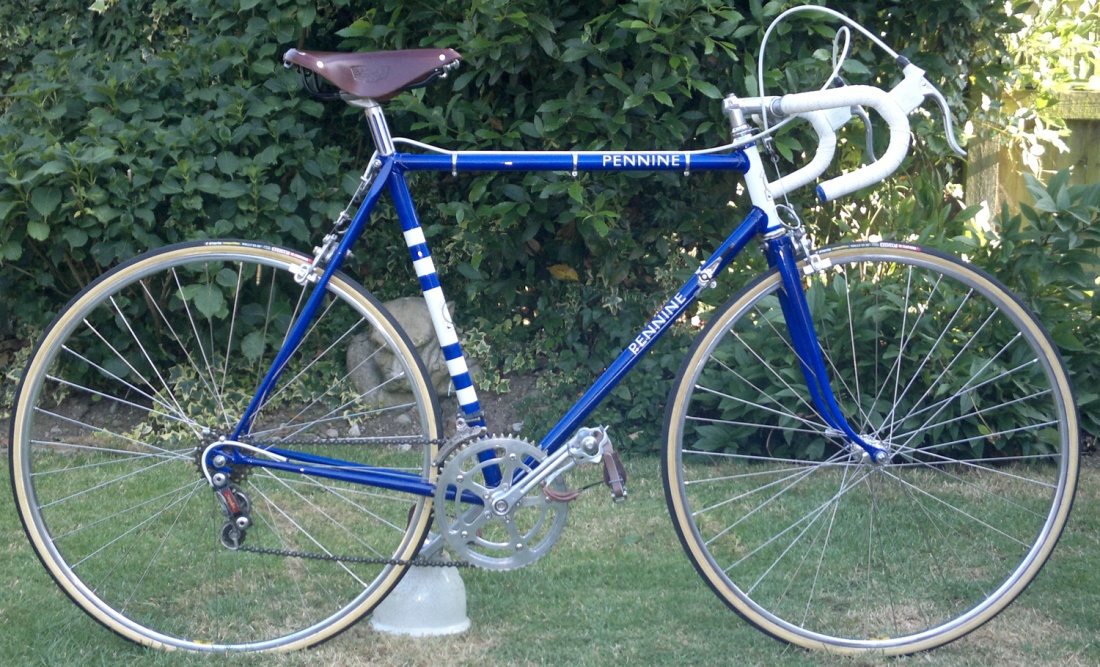
As mentioned above, the seat was not original. I missed out on a Milremo professional by a few pounds but my darling wife saw me looking at the Brooks website and bought me a beautiful B17 Narrow in brown for Christmas. The pedals are currently SR SP150’s (C1975) which look like Campag pedals from a distance. Attached to them are new MKS toe clips with leather trims, also in brown with brown straps and the whole ensemble looks splendid, though not necessarily original. Having said that I have seen photographs of Christophe toe clips with leather covers so they do look ok. If I come across the right Lyotard pedals I’ll get them and put the GB toe clips on.
The B17N is a lovely saddle but the side flaps are quite low. As a result the original seat clamp is a very tight fit beneath it and practically impossible to adjust. A micro adjust post was required, but what? The SR Laprade is not strictly year correct but they do come up relatively cheaply. I found an early SR Laprade fluted stem actually infilled in a blue very close to the frame colour from around 1975 so again not quite original fit but a realistic upgrade.
The GB stem was polished as were the handlebars and put back together. The Universal levers were fitted next and the bars taped with Fizik tapes. The Fizik stuff is quite different to the plastic original but it actually looks the part and is a lot nicer to handle than the original. The amber lever hoods rotted away years ago and when I wanted new ones they were not to be found anywhere. Then on eBay I found a pair of white ones in Italy and bought them. They really look nice and since then I have read that white ones are quite rare. The Universal logo is not infilled in blue like the originals and I daren’t try and do it in case I make a mess of it, so white they shall stay. The little blue Milremo bar end plugs were sourced in the US. The whole assembly looks great. I considered machine polishing all the alloy parts but decided against it because
Many years ago the Campagnolo flat lever skewers began to rust. At the time I wire brushed them and then painted them black. It seemed to stop the rust but meant that cleaning them was a right pain. Replacements were unobtainable, at least at a sensible price (and believe me I looked hard), but because they are such an obvious part of the bike I needed to replace them with similar or preferably the same. The components were available from the US but at silly cost, add on postage and the possibility of Customs and Excise slapping an import duty on and I couldn’t justify it. I managed to buy a pair of curved lever Record ones with the gorgeous bull nose ring adjusters on them for very little money. Typically the following week I got a very good pair of flat level skewers, exactly what I wanted and cheap. Sods law comes into play once again.
Brake blocks proved to be almost the last dilemma. The originals wore out many years ago and were replaced with some shorter ones as a “temporary” measure until I could get the right ones. Of course they never got changed. The holders were quite corroded but they were all I had so I set too cleaning them. Universal brake blocks seem to be stupid money these days, typically £10 each when I was looking. Imagine my delight when I got a set of new old stock blocks, with shoes , delivered for that amount!
So after being assembled in the back bedroom the bike is back together. Finally I took it for a ride for the first time in 26 years. Within a few gentle miles I realised there was something wrong. The tension on the rear Simplex derailleur was very poor. As a result, any excessive pressure on the pedals meant problems as the chain tried to “suck” into the gears and jam itself up. I consulted Mr Google and found some horror stories about plastic Simplex derailleurs of which I have one front and back. Apparently they are made from a DuPont plastic called Delrin. Very good and technical in its day but after 40 years a little suspect. Front derailleur clamps in particular may break and if you are unlucky the cage will fall onto the chain ring, trapping itself between that and the chain and trashing the whole lot! I’ll take pictures for the record but for use I will put something else on there.
The rebuild was carried out in the spare room. My wife didn’t know for a few weeks, the room is little used. Then one day I knew she knew when she shouted downstairs “What is this bike doing in the back bedroom?”. Fair cop. On the bright side it still resides there so it can’t be that bad.
After riding a modern hybrid with a suspension fork and well broken in Brooks saddle, the trauma to my back end from a steel frame, high pressure tubs’ and a brand new Brooks B17 with the yield of a stone was quite significant. I should probably put the new saddle on the hybrid for a while and vice versa.To date the bike has done no more than 10 miles and still needs a lot of fettling and adjustment.
I bought a Campag front mech’ locally and I now intend to get a rear mech’ to match. I had an idea to use Zeus parts but they seem to have escalated in price to stupid levels over the last two years. Still I found other bits and pieces when I thought they were unobtainable. Have patience John….
There are four items I need for period correctness. A pair of Lyotard 460 alloy pedals, a Campagnolo Nuovo Record Pat70 rear derailleur; a 1970 era front changer (which I think would be a 1052/1 but there seem to be loads of different variants), and Campagnolo band on twin down tube levers.
Steve Griffith offers the following for sale;
Two sets of boxed Timkins needle rollers bearings as fitted to some Selbachs £8 each plus postage. B17 oval badge saddle, a bit worn but sound.
Posted: Friday 14th November 2014
Contents
- Introduction
- Images
- Fleur de Lis
- Flanges Image
- Double-Fixed Chater-Lea Hub
- Holdsworth Cyclone De Luxe Lugged Stem
- Prestige Plating
- Table
- Bob Freitas
- Neil McCormick
- Wilson's Cycles
- Tubular Tyre
- Pennine Cycles
- Simplex 537
- The Pennine
- Speed Freewheel
- Campagnolo Nuovo Tipo Hubs
- Campagnolo Flat Lever
- Campag Front Mech
- Steve Griffith
This article appears in the following categories.
Upcoming Events
Whether you are looking for a gentle social meet up, or a 100-mile ride browse the community’s upcoming events and plan your next weekend outing.
